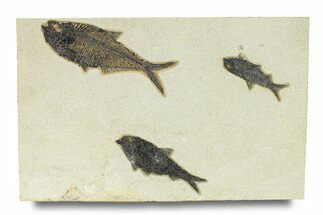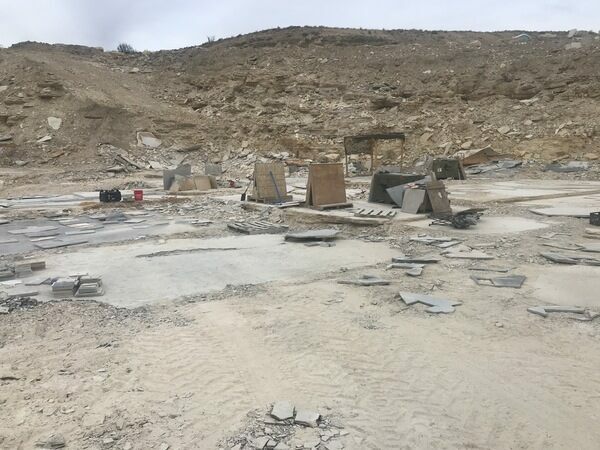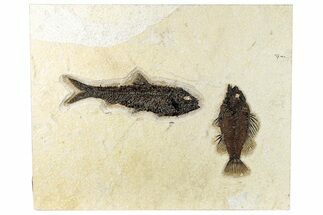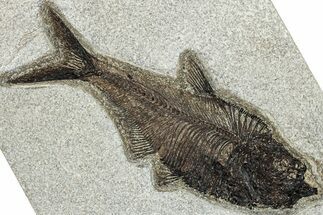This Specimen has been sold.
4.8" Detailed Fossil Fish (Knightia) - Wyoming
This beautiful, 4.8" long fossil fish (Knightia eocaena) from the Eocene-age Green River Formation in Wyoming. It is well-detailed and prepared with bone structure, fins, and scale structure visible.
An acrylic display stand will accompany your purchase.
An acrylic display stand will accompany your purchase.
Knightia is an extinct genus of schooling, ray-finned, spindle-shaped, bony fish that shares a family with herrings and sardines. They lived in the freshwater (lacustrine) environments of North America and were eaten by just about everything that was bigger. They ate insects and smaller fish, and used gill rakers to feast on plankton. Knightia eocena is the largest of the three species of Knightia, with a typical length of about 15 centimeters. It is the state fossil of Wyoming.
These fish had rows of dorsal and ventral scutes running from the back of the head to the medial fins. They had heavy scales, and small conical teeth. They are popular finds in the Wyoming lagerstätte, and were a primary food source to the large and hungry vertebrates of that once hunted the Green River Formation.
The Green River Formation is an Eocene-aged geologic formation that records the sedimentation in a group of intermountain lakes in three basins along the present-day Green River in Colorado, Wyoming, and Utah. The Eocene spanned approximately 55.8 to 33.8 million years ago. This formation has distinct stratigraphy that displays alternating light and dark layers representing seasonal erosion and deposition.
Freshwater basins, charged by the Uinta Mountains on the Wyoming-Utah border, contained an enormous representation of taxa. The beginning of the Eocene was marked by warm upper latitudes, a greenhouse atmosphere rich in methane and carbon dioxide, and local climates stabilized by large lakes populated by such creatures as crocodiles. Fossil Lake in Wyoming, of which the Green River Formation includes, is known for its well-preserved warm, lacustrine ecology.
The end of the Eocene was dramatically different, with the onset of icehouse climate characteristics, a change in atmospheric chemistry, and possible bolide impacts. The Green River fossils date about 48 million years, but cover several million years, including the transition between the moist early Eocene climate and the slightly drier mid-Eocene.
These fish had rows of dorsal and ventral scutes running from the back of the head to the medial fins. They had heavy scales, and small conical teeth. They are popular finds in the Wyoming lagerstätte, and were a primary food source to the large and hungry vertebrates of that once hunted the Green River Formation.
The Green River Formation is an Eocene-aged geologic formation that records the sedimentation in a group of intermountain lakes in three basins along the present-day Green River in Colorado, Wyoming, and Utah. The Eocene spanned approximately 55.8 to 33.8 million years ago. This formation has distinct stratigraphy that displays alternating light and dark layers representing seasonal erosion and deposition.
Freshwater basins, charged by the Uinta Mountains on the Wyoming-Utah border, contained an enormous representation of taxa. The beginning of the Eocene was marked by warm upper latitudes, a greenhouse atmosphere rich in methane and carbon dioxide, and local climates stabilized by large lakes populated by such creatures as crocodiles. Fossil Lake in Wyoming, of which the Green River Formation includes, is known for its well-preserved warm, lacustrine ecology.
The end of the Eocene was dramatically different, with the onset of icehouse climate characteristics, a change in atmospheric chemistry, and possible bolide impacts. The Green River fossils date about 48 million years, but cover several million years, including the transition between the moist early Eocene climate and the slightly drier mid-Eocene.
Specimens like this come from the coveted 18 inch layer of the Green River Formation, which produces darker and more detailed fish than the majority on the market. The rock from this layer is much harder and more durable than other layers in the formation, likely due to its initial deposition conditions in deep water. Because of these conditions, fish found in the 18-inch layer can be extracted whole and in excellent condition. This layer is typically collected at night using low-angle light to see the bump in the rock that the fish's backbone creates. They then cut these fish out and take them to a lab where the fish, which may be up to an inch under the surface of the rock, are meticulously extracted under microscope with hand tools.
50 million years ago, in the Eocene epoch, these fish thrived in Fossil Lake, which was fed by the Uinta and Rocky Mountain highlands. The anoxic conditions at the bottom of Fossil Lake slowed bacterial decomposition, prevented scavengers from disturbing corpses, and, most interestingly, suffocated creatures that ventured into the oxygen-starved aquatic layer. The result is a miraculous exhibition of Eocene biota: a subtropical aquatic community within sycamore forests, teeming with creatures such as freshwater stingrays, dog-sized horses, menacing alligators, early flying bats, and one of the first primates.
SPECIES
Knightia eocaena
LOCATION
Lindgren Quarry, Kemmerer, Wyoming
FORMATION
Green River Formation, Gastropod Layer
SIZE
Fish: 4.8" wide, Rock: 6.9 x 5.95"
CATEGORY
SUB CATEGORY
ITEM
#292500
We guarantee the authenticity of all of our
specimens. Read more about our
Authenticity Guarantee.
specimens. Read more about our
Authenticity Guarantee.
 Reviews
Reviews













